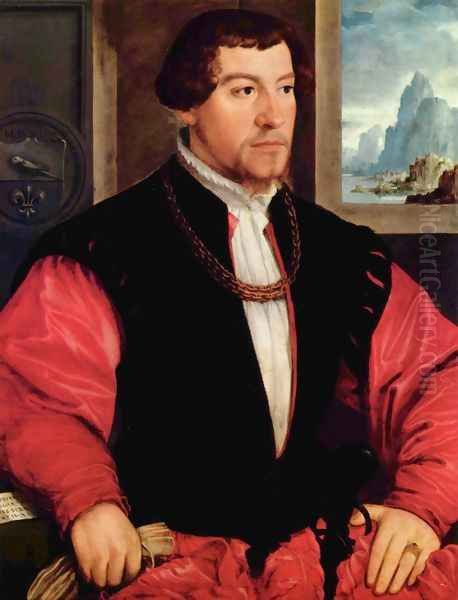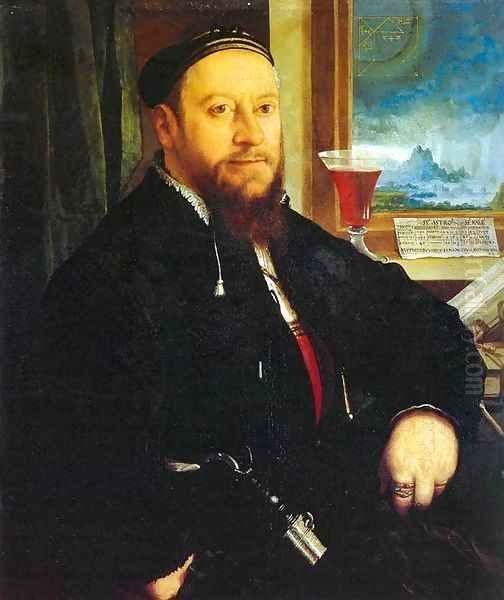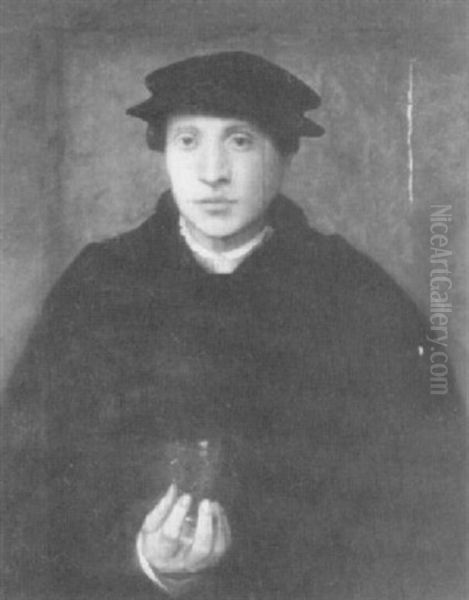Christoph Amberger (circa 1505 – 1562) stands as a significant, if sometimes underappreciated, figure in the landscape of 16th-century German art. Active primarily in the thriving Imperial Free City of Augsburg, Amberger carved out a distinguished career, particularly renowned for his insightful portraiture that captured the likeness and status of prominent citizens, merchants, and even royalty. His work reflects the dynamic artistic currents of his time, skillfully blending the established traditions of Northern European realism with the burgeoning influences of the Italian Renaissance, particularly the Venetian school. This synthesis resulted in a body of work characterized by its technical finesse, psychological depth, and elegant representation.
Early Life and Artistic Formation in Augsburg
The precise details of Christoph Amberger’s birth and early years remain somewhat obscure, a common challenge when studying artists of this period. He is generally believed to have been born around 1505, possibly in the region of Upper Saxony or Swabia. What is more certain is his strong association with Augsburg, a major commercial, financial, and artistic hub in Southern Germany during the Renaissance. It was here that Amberger received his formative training as a painter.
Augsburg, at this time, was a crucible of artistic exchange. Its wealth, derived from international trade and banking, attracted skilled artisans and fostered a climate of patronage. The city was also a frequent host to Imperial Diets, bringing emperors, princes, and their entourages, further stimulating artistic production. It is widely accepted that Amberger was apprenticed in Augsburg, and the painter Leonhard Beck (c. 1480–1542) is frequently cited as his likely master. Beck himself was a respected Augsburg artist, known for his altarpieces, woodcut designs, and portraits, and would have provided Amberger with a solid grounding in the prevailing German artistic traditions.
By 1530, Christoph Amberger had achieved the status of a master within the Augsburg painters' guild. This was a crucial step, granting him the right to establish his own workshop, take on apprentices, and accept independent commissions. This milestone marked the official commencement of a career that would see him become one of the city's most sought-after painters.
The Confluence of Styles: Northern Tradition and Italian Influence

Amberger's artistic development occurred at a time when the innovations of the Italian Renaissance were increasingly permeating Northern Europe. While rooted in the meticulous detail and psychological acuity characteristic of German and Netherlandish art, exemplified by masters like Albrecht Dürer (1471–1528) and Hans Holbein the Younger (c. 1497–1543), Amberger was also receptive to the allure of Italian aesthetics.
It is highly probable that Amberger undertook a journey to Northern Italy, possibly in the late 1520s, before establishing himself as a master. Venice, in particular, with its vibrant artistic scene dominated by figures like Titian (Tiziano Vecellio, c. 1488/1490–1576), Palma Vecchio (c. 1480–1528), and Paris Bordone (1500–1571), seems to have left a lasting impression on him. This exposure is evident in his later works, which show a Venetian sensibility in their richer color palettes, softer modeling of forms, and a greater emphasis on conveying the texture of luxurious fabrics and the status of his sitters.
However, Amberger did not simply imitate Italian models. Instead, he forged a distinctive style that integrated these new ideas with his Northern heritage. His portraits retain a certain sobriety and directness typical of German art, but they are often imbued with an Italianate elegance and a more sophisticated handling of light and shadow. This fusion is a hallmark of his work, distinguishing him from many of his German contemporaries. Other German artists of the period, such as Lucas Cranach the Elder (1472–1553) or Albrecht Altdorfer (c. 1480–1538), developed their own unique responses to the Renaissance, but Amberger's particular blend was well-suited to the cosmopolitan tastes of Augsburg's elite.
Portraitist to the Elite: Capturing Augsburg's Dignitaries
Christoph Amberger’s reputation was built primarily on his exceptional skill as a portraitist. Augsburg, with its wealthy merchant families like the Fuggers and Welsers, provided a fertile ground for portrait commissions. These powerful dynasties, whose commercial empires spanned Europe, were keen to have their likenesses recorded, both as personal mementos and as statements of their social and economic standing. Amberger excelled at fulfilling these desires.
His portraits are characterized by a careful attention to detail in rendering clothing, jewelry, and other accoutrements of wealth, yet they rarely feel merely superficial. Amberger possessed a keen ability to convey the personality and presence of his sitters. Figures are often depicted with a sense of solidity and quiet confidence. The flesh tones are rendered with a clarity and naturalism that speaks to his technical mastery.

Among his notable patrons were members of the Fugger family, one of Europe's most influential banking families. Portraits attributed to Amberger depicting members of this dynasty showcase his ability to convey both individual character and dynastic importance. Similarly, he painted members of the Welser family, another prominent Augsburg merchant clan. These commissions underscore his position as the go-to artist for Augsburg's upper crust.
Imperial Recognition: The Portrait of Charles V
Perhaps the most significant testament to Amberger's skill and reputation was his commission to paint Emperor Charles V (1500–1558). The Holy Roman Emperor was in Augsburg in 1532 for the Imperial Diet. During this period, Amberger created a portrait of the powerful ruler. This work, often compared favorably with portraits of the Emperor by the great Titian, was reportedly highly praised by Charles V himself. Such imperial approbation would have undoubtedly enhanced Amberger's prestige and secured his standing as a leading painter.
The "Portrait of Charles V" (c. 1532, now in the Gemäldegalerie, Berlin) showcases Amberger's mature style. The Emperor is presented with a commanding presence, yet there is also a hint of introspection. The rich attire is meticulously rendered, but the focus remains on the Emperor's face and expression. This work demonstrates Amberger's ability to operate at the highest levels of patronage, competing stylistically with international masters. Titian, who also famously portrayed Charles V on multiple occasions, including the "Emperor Charles V at Mühlberg," set a high bar for imperial portraiture, and Amberger's success in this arena is noteworthy.
Key Representative Works
Beyond the celebrated portrait of Charles V, several other works exemplify Amberger's artistic achievements:
"Portrait of Christoph Baumgartner" (1543, Kunsthistorisches Museum, Vienna): This is one of Amberger's most famous and accomplished portraits. Baumgartner, an Augsburg patrician, is depicted half-length, clad in dark, luxurious fur-trimmed attire. The painting masterfully combines Northern precision in the rendering of facial features and textures with a Venetian sense of color and composition. The sitter's gaze is direct and intelligent, conveying a sense of calm authority. The rich, dark background and the subtle play of light on the face and hands contribute to the painting's dignified atmosphere.
"Portrait of a Man from the Dichtel Family" (c. 1545-1550, Art Institute of Chicago): This work shows a confident sitter, his hand resting on a table. The meticulous detail in the fur collar and the delicate rendering of the beard are characteristic of Amberger's skill. The psychological insight, capturing a sense of the sitter's personality, is also evident.

"Portrait of Ambrosius Jung" (1540s): Ambrosius Jung was a learned physician and humanist in Augsburg. Amberger's portrait of him (the location of the original may vary, with versions or copies existing) would have aimed to capture not just his physical likeness but also his intellectual stature, a common aspiration in Renaissance portraiture influenced by figures like Hans Holbein the Younger, who masterfully portrayed scholars such as Erasmus.
"Portrait of a Member of the Welser Family" (various examples exist): These portraits, like those of the Fuggers, would have emphasized the wealth and status of this powerful merchant family. Amberger's ability to render luxurious textiles and convey an air of patrician dignity was highly valued by such patrons.
"Portrait of Matthäus Schwarz" (c. 1542, Thyssen-Bornemisza Museum, Madrid): Schwarz was the chief accountant for the Fugger family and famously commissioned the "Trachtenbuch" (Book of Costumes), a unique manuscript illustrating his changing fashions throughout his life. Amberger's portrait captures this fashion-conscious and important figure with characteristic precision and elegance. The work is notable for its refined execution and the sitter's direct engagement with the viewer.
Religious Works and Other Commissions
While primarily known for his portraits, Christoph Amberger also undertook religious commissions. The Reformation had a profound impact on religious art in Germany, with some areas seeing a decline in traditional Catholic imagery. However, Augsburg, with its mixed religious population and strong Catholic presence, continued to commission religious works.
Amberger's most significant religious work was the high altarpiece for the Augsburg Cathedral, depicting the "Adoration of the Magi" (also referred to as the "Triptychon" or Three Kings). Completed around 1554, this large-scale work would have been a major undertaking. Unfortunately, like many large religious pieces from this era, it has not survived intact, likely falling victim to later iconoclasm or alterations to the cathedral. However, records and perhaps surviving fragments or preparatory studies might offer glimpses into its composition and style. The choice of the Adoration of the Magi was a popular theme, allowing for rich depictions of exotic figures and lavish gifts, appealing to Renaissance tastes.
Another religious work sometimes attributed to him or his workshop is a "Madonna and Saints" altarpiece, also for the Augsburg Cathedral. The survival rate for large-scale religious art from this turbulent period is often poor, making a full assessment of this aspect of his oeuvre challenging. Artists like Matthias Grünewald (c. 1470–1528) with his Isenheim Altarpiece, or Albrecht Dürer with his religious engravings and paintings, set a high standard for German religious art, and Amberger would have been working within this rich, albeit changing, tradition.
Beyond painting, Amberger also contributed designs for other artistic media. Notably, he is credited with providing designs for ten of the monumental bronze statues surrounding the cenotaph of Emperor Maximilian I in the Hofkirche in Innsbruck. This grand project, initiated by Maximilian and continued by his grandson Emperor Ferdinand I, involved numerous artists. Amberger's involvement in designing some of these ancestral figures, which were then cast by other craftsmen, speaks to his versatility and esteemed reputation, placing him in the company of other leading artists of the German-speaking lands who contributed to this imperial monument, such as Jörg Kölderer and Gilg Sesselschreiber.
Amberger and His Contemporaries
Christoph Amberger operated within a vibrant network of artists, patrons, and intellectuals. His presumed master, Leonhard Beck, was a significant local figure. His connection to the Augsburg Cathedral and prominent families like the Fuggers and Welsers placed him at the center of the city's artistic life.
His style shows an awareness of the work of Hans Holbein the Younger, another Augsburg-born artist who achieved international fame, particularly in England. While Holbein left Augsburg relatively early in his career, his standards of psychological penetration and meticulous realism in portraiture would have been known. Amberger's work, while distinct, shares some of this Northern European concern for verisimilitude.
The documented meeting with Titian in Augsburg in 1548, when Titian was present to paint Emperor Charles V and his court, is significant. This encounter would have provided Amberger with direct exposure to one of the towering figures of the Venetian Renaissance. While Amberger's Italianate tendencies were likely already established, such a meeting could only have reinforced or further nuanced his appreciation for Venetian colorism and compositional strategies. Other Venetian masters whose work Amberger might have known, either through travel or prints, include Giorgione (c. 1477/8–1510), whose enigmatic and atmospheric paintings revolutionized Venetian art, and Giovanni Bellini (c. 1430–1516), a foundational figure for the Venetian school.
In the broader German context, Amberger was a contemporary of artists like Hans Baldung Grien (c. 1484–1545), known for his often dramatic and unconventional imagery, and Jörg Breu the Elder (c. 1475–1537), another Augsburg artist active in painting and stained glass design. The Augsburg school also included Hans Burgkmair the Elder (1473–1531), a pioneer in adopting Italian Renaissance forms in Germany. Amberger's career unfolded in the generation following these early adopters, building upon their achievements.
Netherlandish portraiture, with its refined technique and realism, also formed part of the broader artistic environment. Artists like Jan Gossaert (c. 1478–1532) and Joos van Cleve (c. 1485–1540/41) were influential in popularizing Renaissance motifs in the North, and later, Anthonis Mor (Antonio Moro, c. 1517–1577) would become a leading international court portraitist, whose work shares some of the dignified realism seen in Amberger's portraits.
Personal Life and Social Standing
Details about Amberger's personal life are, like his early years, somewhat sparse. It is known that he married Barbara Beck, the daughter of his presumed master, Leonhard Beck. This marriage would have further solidified his position within Augsburg's artistic community. The couple is known to have had children, continuing his lineage.
His success as a painter afforded him a comfortable social standing. Being the preferred portraitist for the city's elite and receiving commissions from the Emperor himself indicates a high level of professional respect and financial success. He owned property in Augsburg and was an established member of the community.
One anecdote that occasionally surfaces concerns the social distinctions of the time. It is sometimes mentioned that while Amberger himself achieved considerable status, his wife, due to her artisan-class background (daughter of a painter), might not have been eligible for entry into the most exclusive patrician circles of Augsburg society, highlighting the era's rigid social hierarchies. However, Amberger's own professional success and connections clearly allowed him to navigate these circles effectively as an artist. He remained active in Augsburg for the entirety of his mature career.
Later Years, Death, and Legacy
Christoph Amberger continued to work productively throughout the 1540s and 1550s. He passed away in Augsburg, likely between August 1561 and August 1562, as guild records and other documents suggest. He left behind a significant body of work that captured the likenesses of a generation of Augsburg's leading citizens and contributed to the city's reputation as an artistic center.
In the centuries following his death, Amberger's name, like those of many competent but not superstar-level Renaissance masters, sometimes faded from broader art historical narratives, which tended to focus on the very top tier of innovators like Dürer or Holbein in the North, or the Italian giants. His specialization in portraiture, while lucrative and highly valued in his time, sometimes led to him being overshadowed in art historical accounts that prioritized large-scale religious or mythological paintings.
However, modern scholarship has increasingly recognized Christoph Amberger's importance. He is now firmly regarded as one of the leading German painters of the mid-16th century and arguably the most important portraitist active in Augsburg during his lifetime. His ability to synthesize Northern and Italian artistic elements created a style that was both sophisticated and accessible, perfectly suited to the tastes of his discerning clientele.
His works are now found in major museums across the world, including the Gemäldegalerie in Berlin, the Kunsthistorisches Museum in Vienna, the Alte Pinakothek in Munich, the Thyssen-Bornemisza Museum in Madrid, and the Art Institute of Chicago, among others. These collections allow contemporary audiences to appreciate his technical skill, his insightful characterizations, and his contribution to the rich tapestry of Renaissance art.
Conclusion: Reappraising an Augsburg Master
Christoph Amberger's career exemplifies the artistic vitality of Augsburg during the German Renaissance. As a master portraitist, he not only provided invaluable visual records of the individuals who shaped his society but also created works of enduring artistic merit. His skillful fusion of the meticulous realism of the Northern tradition with the elegance and chromatic richness of Venetian painting allowed him to develop a distinctive and highly successful personal style.
While he may not have achieved the revolutionary status of a Dürer or a Titian, Amberger was a master craftsman and a sensitive observer of humanity. His portraits offer a window into the world of 16th-century Augsburg, reflecting its wealth, its civic pride, and its cultural connections to both Northern Europe and Renaissance Italy. His legacy is that of a highly accomplished artist who played a crucial role in the visual culture of his time and whose works continue to engage and impress viewers with their quiet dignity and refined execution. Christoph Amberger rightly deserves his place as a key figure in the German Renaissance.